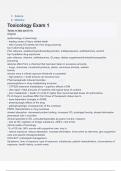1. Science
2. Medicine
Toxicology Exam 1
Terms in this set (111)
Original
epidemiology of poisonings
- leading cause of injury related death
- half of yearly ED admits are from drug poisoning
top 5 adult drug exposures
Pain relievers, sedative/hypnotics/antipsychotics, antidepressants, antihistamines, alcohol
top 5 pediatric drug exposures
pain relievers, vitamins, antihistamines, GI preps, dietary supplements/herbals/homeopathic
poisoning
adverse effect from a chemical that has been taken in excessive amounts
- drugs, chemicals, household products, plants, venomous animals, warfare
toxicity
ensues once a critical exposure threshold is exceeded
- high potency = small amount can become toxic
Pharmacogenetic induced toxicities
%
polymorphisms in drug metabolizing enzymes
- CYP2D6 extensive metabolizes = euphoric effects of DM
- ultra rapid = fatal amounts of morphine with typical dose of codeine
- poor metabolizer = death of a child in higher than recommended doses of hydrocodone
Pk of drugs in overdose differ from those of therapeutic doses due to
- dose dependent changes in ADME
- pharmacologic effects of the drug
- pathophysiologic consequences of the overdose
PKPD characteristics in drug overdose
slowed absorption, decreased protein binding, increased VD, prolonged toxicity, slowed elimination
pharmacist role in toxicities
clinical specialist in ED, consultant/specialist at poison Control, research,
- look at OD, ingestion of foreign substance, ADE's, med errors
clinical reality of toxicology
1% of OD die, 99% survive with supportive care. key to
- reduce exposure, reduce absorption, increase elimination, know when to intervene, give supportive
care and specific therapy/antidotes
COLLECT: prehospital management
Symptoms, time of exposure, type of exposure, substances, patient characteristics, circumstance of
exposure, health history, current meds
, - objective: # consumed, exact product and strength
ASSESS: prehospital management
- emergent symptoms: unresponsive, seizure, SOB, slow/shallow breathing
Ask yourself: is exposure likely to produce these symptoms within 1 hour?
presence of potential high risk factors: child resistant container, signal words on label, debilitated,
homicide, suicide intent, abuse
- ability to contact poison control, 911, or give naloxone
PLAN: prehospital management
- emergent symptoms = 911
- unresponsive and depressed respiration = opioid? = Narcan 911
- refer to poison control to assess product toxicity, therapeutic actions and needed for hospital
treatment
- if no referral, explain self monitoring for symptom development or resolution
IMPLEMENT: prehospital management
of hospitalized, assess if substance abuse or homicide or family abuse
- provide instructions on contacting poison control
- if meds used incorrectly, refer to PCP for counseling
FOLLOW UP: prehospital management
patient condition, response to treatment, symptom resolution, adherence to referral
- safety proof house
ABCDEFG of managing acutely toxic patient
%
airway, breathing, circulation, decontamination, enhanced elimination, focused antidote therapy, get
help
initial principles of hospital assessment
airway, if inadequate (GCS < 8, irregular or slow breathing, coma signs) adjust it
- then assess breathing, circulation and prefusion
vital signs to collect
BP, pulse, RR, O2 and temp
labs to collect
Chem7, INR, ABG, carboxyhemoglobin, methemoglobin, bg
- pulse ox, end total CO2, 12 ECG
assess CNS to diagnose
altered mental status from baseline
- agitation, delirium, psychosis, lack of consciousness
- treatment = supportive care = oxygen, CPR, fluids, antidysrythmIc, vasopressors, inotropes
- coma cocktail = dextrose, naloxone, thiamine, oxygen
assess other to diagnose
- trauma, pasture, withdrawal, pupil size and reactivity to light, GCS
- breath or skin odors
identify toxidrome




